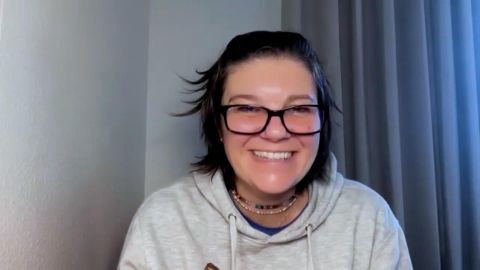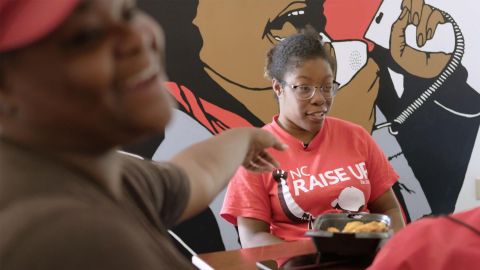A little girl once said, "There
is no place like home." But for
many children, clicking your
heels three times like Dorothy
did is no remedy for
homelessness.
Steve Lopez is a columnist for
The L.A.
Times, who recently published a
four part series on child
poverty in L.A., focusing on the
stories from Telfair Elementary
School, where nearly a quarter
of the student body is homeless.
Many live in motels and garages.
They have little to eat and
nowhere to do homework.
They are victims of rising
housing costs.
Our Hari Sreenivasan sat down
with Steve Lopez ontinuing our
ongoing initiative about
poverty, jobs and economic
opportunity in America called
Chasing the Dream.
Steve Lopez, you did a four part
series on child poverty in Los
Angeles.
You spent months looking at one
school.
Why?
I was curious about how it could
be that California could have
the fifth largest economy in the
world, not the nation but in the
world, and yet about 20 percent
of the population living in
poverty and when you break those
numbers down, it means there are
about 2 million children in
California living in poverty and
one day I bumped into the
superintendent of Los Angeles
Unified School District and he
was new on the job and asked how
it was going and he mentioned
that the challenges are many and
asked if I was aware that there
are a couple of schools where
nearly a quarter of the student
body was homeless, so I decided
to check that out and one of
those schools is Telfair
Elementary, so I spent several
weeks hanging around there
talking to teachers, to the
principal and to families.
So what does it look like if a
quarter of the school population
is homeless.
How do they, we're not talking
about people panhandling on the
streets, it's different kind of
homelessness.
It is a different kind of
homelessness.
We're not talking about students
camped in tents outside the
front office of the school.
What happens is that families
each year in Los Angeles Unified
are asked to fill out a
residency questionnaire and you
have to check these boxes.
Do you live in a motel?
Do you live in a vehicle?
Do you live in a shared
apartment or home or do you live
in a place of your own?
And a shocking number of
students in Los Angeles Unified,
a couple of years ago it was
17,000 checked one of those
boxes and last year 15,000 plus
and little Telfair Elementary
School, which only had about 750
or 60 students had more than
anybody, they had about a
hundred and eighty of their
students who had checked one of
those boxes and a third of those
were living in garages in the
neighborhood.
You mean the garages that are
attached to homes, just where we
would normally park our cars?
Where you would keep your
lawnmower and your motor oil,
yes, no there is, it's actually
become quite an industry in Los
Angeles.
It's not entirely new, it's just
that in this economy the housing
costs are still rising way
faster than wages are rising, so
people are, you know, stretched
to the limits and there are all
of these creative living
arrangements and I spoke to one
real estate agent who recently
sold a four bedroom house to
somebody who was going to live
in a back shanty and rent three
of the bedrooms for seven
hundred dollars a month each and
the one bedroom that had a
bathroom was going to go for
about 950.
So you have families living in
situations like that all around
Telfair Elementary School.
These are not low prices.
Why do people agree to pay some
of these prices or are you also
mention that they're living in
motels.
That's not an economic option.
No there are no economic options
in Los Angeles right now.
We've had, because of a housing
shortage, a skyrocketing of
rents of every kind, so it's not
uncommon to find somebody living
in a garage paying fifteen
hundred dollars a month.
Now these are garages that, you
know, they've been converted,
some of them have bathrooms,
there's running water, some of
them have kitchens, so it's kind
of like in many cases maybe a
studio apartment or a one
bedroom.
So they're not necessarily
horrible living conditions but
when you have families and you
have children in school and
there's no quiet place to do the
homework and there's no yard to
go out side and play in because
the owners families out there,
it puts all of these burdens on
these families and then those
burdens transfer over to the
schools because teachers will
tell you about students who show
up who maybe didn't have a
nutritional hot meal or they
didn't get their homework done
because they didn't have a quiet
place to do it.
They're not focused on on the
lesson plan that day because
maybe somebody next door was
noisy and they didn't get any
sleep, so all of these burdens
walk into these classrooms every
day at Telfair.
You focused on for one of the
stories, there is video of a
family that you meet who is
living in a motel.
Just the act of getting the
children to school on a daily
basis is an uncertainty.
That's right.
Two months into the current
school year the family had lived
in three or four different
places.
They were in a motel, moved into
an apartment that was a two
bedroom one bath that 17 people
were living in.
That wasn't working out, so
moved back to a motel, but the
cheapest motel was six miles
from school and the mother
doesn't have a car, so it was
either public transportation or
call a relative a friend and
hoped somebody would take the
kids to school and sometimes
they showed up and sometimes
they didn't and in that motel
room--this is one room--it''s a
small room with two beds.
There is no kitchen.
There is no desk, no place to do
your homework.
The place is kind of noisy.
There's some nefarious
activities going on in that
motel and all the surrounding
motels and this is how thousands
of children are growing up in
Los Angeles.
One of the things that strikes
me about that video is the
mother's concerns about
malnutrition, that she is not
able to feed her children
regularly.
"The last two days we didn't
have no food until yesterday and
it gets hard.
It just, it hurts me to see them
hungry."
You know when I was in the motel
room, I saw a 7-Eleven pizza box
and this was early in the
morning, so I assumed it was
from the night before, which I
guess it was and when the ride
was not showing up to take the
three kids to school, one of the
one of the kids the little girl
who was 5 years old was getting
hungry, so she walked over
opened up that 7-Eleven pizza
box and put a piece of pepperoni
pizza into the microwave and
that was breakfast.
I mean the one thing these kids
look forward to is school is
kind of an oasis.
It's safe, they serve you they
serve you hot meals, but if you
don't get to school you don't
get to take advantage of those.
So what happens to these
children?
What are the ripple effects?
What are the forces that are
weighing on them by the time
they get to class?
Well, you know, teachers talk
about how they're a little
unfocused.
Maybe they're tired, maybe they
didn't do their homework, maybe
they ate something, but it
wasn't the best food to prepare
you for a day in school, so
there are those things and then
it becomes a little more
serious.
They find irritability, they
find mood disorders, high rates
of depression, even among
elementary school students, and
the thing that's of even greater
concern is all of this recent
research about adverse childhood
experiences and the more of
these that you're exposed, to
including unstable housing
situations and broken families
and not enough of an income to
to get you to school regularly
or to put food on the table, you
have not just physical and
mental challenges and ailments
as a child, but they're finding,
researchers are, that these are
lasting into adulthood something
like twice the normal rate of
heart disease if you're exposed
to four or more of these adverse
childhood experiences, so this
is not just a problem in K
through 5 for these kids.
This is something that may be
with them for a lifetime.
It also sounds like a teachers
here are the frontlines for not
just teaching, but everything
else.
I mean you're describing a
social worker or a team of
social workers that would have
to grapple with any of these
specific challenges
individually, but really the
only person that's going to have
to face this for 15 or 20 kids
in her or his classroom is that
teacher.
You know, we look at some of the
test scores at schools like
Telfair and we sit back in
judgment and oh that school is
failing.
What I saw was inspirational and
you're right, teachers are
social workers, sometimes
they're parents.
They were a lot of different
hats and they're dealing with
problems that come in with these
kids because of the conditions
they're living in and I should
tell you that if you drive just
a few miles from Telfair
Elementary you can see where the
Lockheed Martin plant closed,
you can see where the GM auto
manufacturing plant closed,
where the Price Pfister kitchen
faucet plant closed and all of
those jobs were replaced, which
were middle income jobs, were
replaced by service economy
jobs, so a lot of these families
I'm talking about that are
living in motels, some of them
in vehicles, some of them in
garages, they're not sitting
around all day.
These are working families, but
we have an economy that is
serving a just a few people at
the top and those in the middle
at the bottom are struggling, so
the Telfair story is not just
about child poverty, it's about
this economy, it's about
something broken in California.
How can you have this state that
has such incredible staggering
wealth, hundreds of
billionaires, fifth largest
economy in the world and
thousands, actually millions of
children living in poverty.
Something's broken and I have
not yet met anybody who has any
ideas on how to really address
that.
You're pointing to something
systemic.
You're pointing to something
also generational when some of
these children grow up in these
situations, they're almost
trapped.
The odds are really against them
and that was another thing that
really inspired me about this
school, Telfair.
The teachers believe in them,
the teachers believe that each
of them can make it under the
right circumstances and they
know that they come from, you
know, living conditions that can
be pretty depressing and they
want the school to be an
uplifting, safe, comfortable
place and the person who sets
the tone for that is the
Principal, Jose Razo.
Jose Razo grew up just a few
blocks from Telfair Elementary
and when he was a boy, lived
with his mother and his siblings
for a while in a garage and Jose
tells the story about that
garage not having a bathroom and
if you needed to use the
restroom, you had to walk
outside the garage go around, go
up knock on the front door of
the owner the owner's house and
ask permission to use the
bathroom.
This is a guy who had faith, he
had his mother behind him saying
your faith and education is
going to get you through it.
He did well in school, he played
in the band in high school, he
joined the United States Marine
Corps, he came back, he started
as a teacher's aide and then
became a teacher and then wanted
to run a school and he runs this
school with banners, college
university banners are hanging
from the hallways from the
auditorium from the first day.
It's not are you going to
college, kids, which one are you
going to go to.
On Fridays you don't have to
wear your uniform to school if
you wear a university t shirt or
a sweater, so this is a really
sad story, it's tragic, but I've
found great inspiration in the
attitudes and the hard work and
the ethic of the principal and
his teachers.
You know, one of the things that
your stories also point out is
that if we just looked at the
test scores, we'd miss the
nuance that you're describing
here.
We wouldn't see the
inspirational and I think one of
the people in the story had said
the test scores really are much
more of a measure of poverty not
necessarily of their potential.
Yeah I think that it's a measure
of poverty rather than promise.
These are smart kids and when
they have access to the right
things I think there's no limit
on what they can accomplish, but
let's take a look at Telfair and
what do they have, or what do
they not have.
Given all of this trauma, you'd
think they would have a
psychiatric social worker.
They do not.
You'd think they'd have a nurse.
The nurses are only a couple of
days a week.
You'd think you'd want to expose
them to reading and to you know
the power of words.
The library is usually closed.
These are the problems we're
seeing at a school in a district
in a state that when I was in
public school, this is a few
years ago in California,
California was a model for the
nation.
Schools were well funded.
The resources were there and
those schools helped drive what
became this great powerful
economic engine in California.
We short shrift our kids today.
How can you have a situation
like that in this economy, with
this level of poverty and not
have the tools that the students
need to succeed?
That part of this is tragic and
very discouraging.
One of the statistics that leapt
out to me and other people when
we were reading the story, you
said 80 percent of the students
at the L.A.
Unified School District qualify
for free or reduced lunch.
That's 480,000 kids out of the
600,000 that go to this school
district.
Imagine that.
Imagine that and yet we've had
these conversations about gee,
what's wrong with the schools,
do we need more charters.
Is the teacher's union union
running things, and we do we
need to crack down on that.
Let's have another politicized
school board election.
What I think I discovered in
working on the series was that
the schools are not the problem,
society is.
Everything else is.
We're the problem.
We are expecting schools to
address the shortcomings in this
economy and they're doing their
best.
Many of them, sure they could
improve, sure we need to find
new ways to support the schools
and help them do better, but
we've got much bigger problems
than what's going on in the
schools.
As you look at this problem,
what have you seen?
Have you seen anybody tackle
this in a successful way?
You often hear people say that
let's not throw more money at
this problem and those tend to
be people whose children are not
at those schools.
I mean, when you don't have a
nurse and you don't have a
library that you can keep open,
yes, money would help.
Some recent studies have have
determined that that one problem
in California, more so than in
other states, maybe it's because
of the large poor community and
large immigrant population, is
that once students in California
begin school, they do as well as
students in other states, but
they begin further behind and so
there is talk about a new focus
in California on preschool
intervention, on very early
childhood education, on a better
system of coordinating all of
those kinds of services, more
parent coaching.
I'd like to see school campuses
become community centers.
This is an idea I got many years
ago from New Jersey Senator Bill
Bradley who was running for
president and I was out on the
campaign trail and he asked,
when he made his campaign stops
in many neighborhoods in
America, he said a public school
campus is the only safe oasis
and it's a place where you may
have the only library and the
only gymnasium and the only
place with all of these
resources.
Why do we lock the doors at 3pm?
Why don't we keep those up and
make them community centers
where people with a trade can
come and talk about how they got
into that business, where the
kids have access to the books
and the library.
I think we need to rethink what
can be done with school campuses
and also what can be done to get
kids better equipped before
kindergarten so that they're
ready for school.
All right, Steve Lopez, the four
part series is at the L.A.
Times.
Thanks so much.
Thank you.



